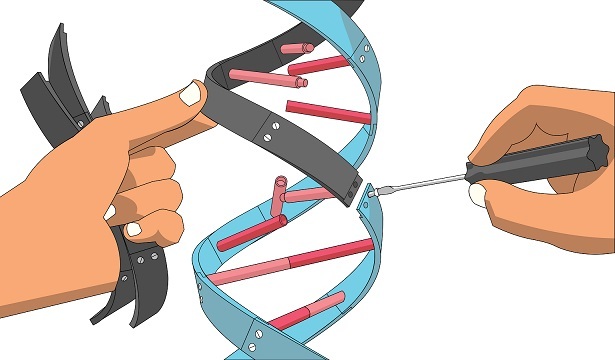
 Data Structure
Data Structure Networking
Networking RDBMS
RDBMS Operating System
Operating System Java
Java MS Excel
MS Excel iOS
iOS HTML
HTML CSS
CSS Android
Android Python
Python C Programming
C Programming C++
C++ C#
C# MongoDB
MongoDB MySQL
MySQL Javascript
Javascript PHP
PHP
- Selected Reading
- UPSC IAS Exams Notes
- Developer's Best Practices
- Questions and Answers
- Effective Resume Writing
- HR Interview Questions
- Computer Glossary
- Who is Who
What are Endonucleases and What are its Types?
Introduction
Endonucleases are a class of enzymes that can cleave the phosphodiester bonds within a DNA or RNA molecule. These enzymes play a crucial role in various biological processes such as DNA repair, replication, transcription, and recombination. Endonucleases are also widely used in biotechnology, particularly in molecular biology, for various applications such as genetic engineering, gene therapy, and DNA sequencing.

Types of Endonucleases
There are several types of endonucleases, classified based on their structure, function, and specificity. Some of the most common types of endonucleases are ?
Restriction Endonucleases
Restriction endonucleases, also known as restriction enzymes, are a type of endonuclease that cleaves DNA at specific recognition sequences. These enzymes are produced by bacteria and are used in genetic engineering to cut DNA at specific sites, allowing for the insertion, deletion, or modification of genes. Restriction enzymes have different recognition sequences and can produce either blunt or sticky ends after cleavage.
Homing Endonucleases
Homing endonucleases, also known as meganucleases, are a type of endonuclease that can recognize and cleave long DNA sequences with high specificity. These enzymes are found in many organisms, including bacteria, fungi, and animals, and are involved in various biological processes such as DNA repair and recombination. Homing endonucleases have the potential to be used as tools for gene therapy and genome editing due to their high specificity.
Endonucleases Involved in DNA Repair
There are several endonucleases involved in DNA repair, including the apurinic/apyrimidinic endonuclease (APE), which cleaves DNA at sites where a base has been lost, and the flap endonuclease (FEN1), which cleaves the DNA flap during DNA replication and repair. These endonucleases are essential for maintaining the integrity of the genome and preventing mutations that can lead to diseases such as cancer.
Endonucleases Involved in RNA Processing
Endonucleases are also involved in RNA processing, such as the ribonuclease III (RNase III), which cleaves double-stranded RNA molecules into smaller fragments, and the endonuclease XendoU, which cleaves the 3' end of the precursor to small nucleolar RNA (snoRNA). These endonucleases are important for the maturation of various types of RNA molecules, including messenger RNA (mRNA), ribosomal RNA (rRNA), and transfer RNA (tRNA).
Endonucleases Involved in Retrotransposition
Retrotransposition is a process where a retroelement, such as a retrovirus or a transposable element, inserts a copy of its DNA into a new location in the genome. Endonucleases, such as the endonuclease encoded by the LTR retrotransposon Ty1 in yeast, are essential for this process as they cleave the DNA at specific sites, allowing the retroelement to integrate into the genome.
Functions of Endonucleases
Endonucleases have a variety of functions, depending on the type of enzyme and the biological context in which it is found. Some of the most common functions of endonucleases are ?
Endonucleases are a type of enzyme that cleaves phosphodiester bonds within a DNA or RNA molecule. These enzymes play a critical role in various biological processes, including DNA repair, recombination, and restriction/modification systems.
DNA Repair
Endonucleases are involved in the repair of damaged DNA by cleaving the damaged nucleotide or fragment of DNA, which is then replaced by a new one. This repair mechanism is essential for maintaining the integrity of the genome and preventing mutations that can lead to diseases such as cancer.
Recombination
Endonucleases also play a crucial role in homologous recombination, a process in which two DNA molecules exchange genetic information. During this process, endonucleases create a double strand break at a specific site in the DNA molecule, allowing the exchange of genetic material between two DNA strands. This process helps to generate genetic diversity and also plays a role in DNA repair.
Restriction/Modification Systems
Endonucleases are also involved in bacterial defense mechanisms called restriction/modification (R/M) systems. These systems are responsible for protecting bacterial cells from foreign DNA, such as viral DNA. Restriction endonucleases cleave foreign DNA at specific recognition sites, while modification enzymes protect the host DNA from being cleaved by the restriction enzymes. These systems have important applications in molecular biology, such as DNA cloning, gene editing, and genetic engineering.
Types of Endonucleases
Restriction Endonucleases: These are enzymes that cleave DNA at specific recognition sites. They are used in molecular biology to cut DNA at specific sites to create fragments for cloning or to generate recombinant DNA molecules.
Homing Endonucleases
These are enzymes that are encoded by introns or inteins and can cleave DNA at specific sites. They are involved in the mobility of introns or inteins within the genome.
Nicking Endonucleases
These are enzymes that cleave only one strand of DNA, creating a nick in the phosphodiester backbone. They are used in molecular biology for applications such as site-directed mutagenesis, DNA sequencing, and recombinant DNA technology.
Conclusion
Endonucleases play a vital role in various biological processes, including DNA repair, recombination, and restriction/modification systems. The different types of endonucleases have specific functions and applications in molecular biology, making them essential tools for genetic research and biotechnology.

